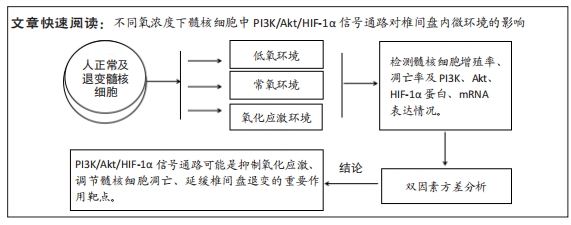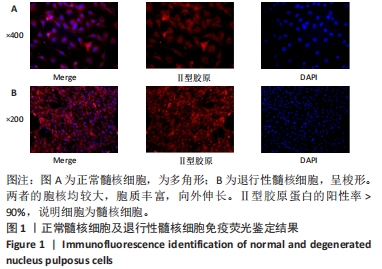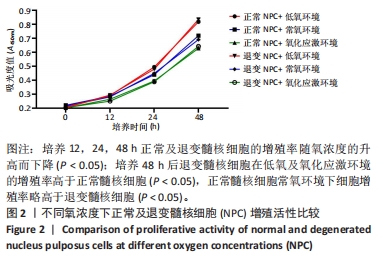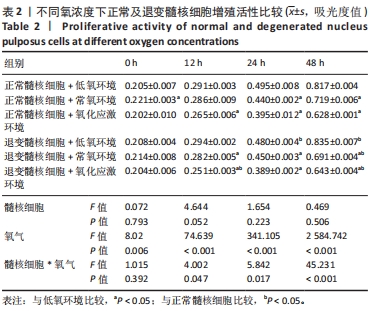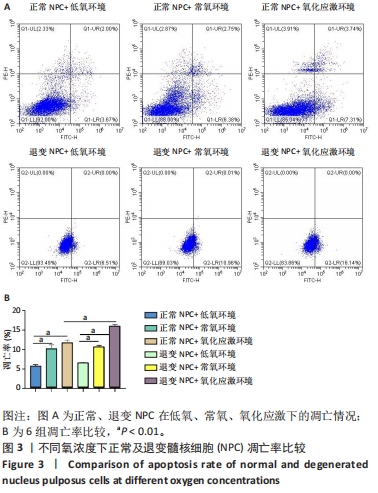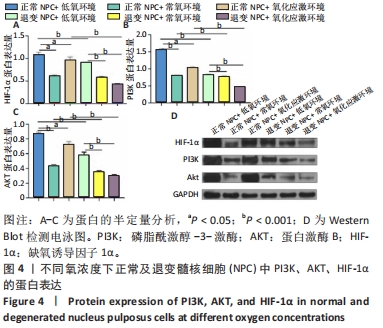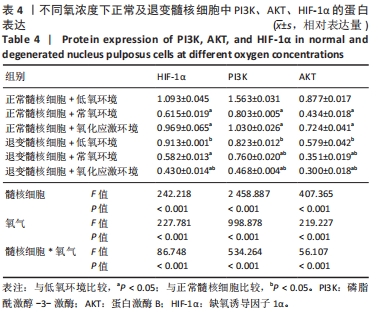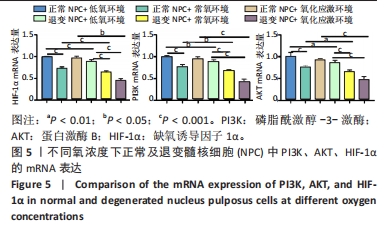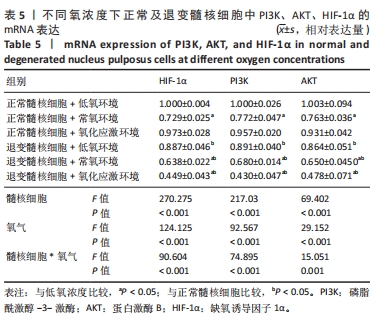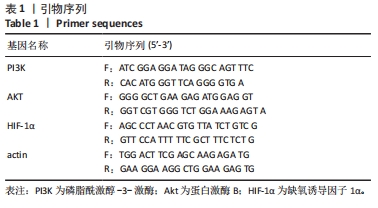[1] PULICKAL T, BOOS J, KONIECZNY M, et al. MRI identifies biochemical alterations of intervertebral discs in patients with low back pain and radiculopathy. Eur Radiol. 2019; 29(12):6443-6446.
[2] 刘鑫,胡满,赵文杰,等.镉暴露激活PI3K/Akt信号通路诱导椎间盘纤维环细胞衰老[J].中国组织工程研究,2024,28(8):1217-1222.
[3] VO NV, HARTMAN RA, PATIL PR, et al. Molecular mechanisms of biological aging in intervertebral discs. J Orthop Res. 2016;34(8):1289-1306.
[4] HUANG YC, LEUNG VY, LU WW, et al. The effects of microenvironment in mesenchymal stem cell-based regeneration of intervertebral disc. Spine J. 2013;13(3):352-362.
[5] FENG G, JIN X, HU J, et al. Effects of hypoxias and scaffold architecture on rabbit mesenchymal stem cell differentiation towards a nucleus pulposus-like phenotype. Biomaterials. 2011;32:8182-8189.
[6] 曹志鹏,石宇,李克,等.碳点-普鲁士蓝纳米酶抗氧化应激延缓椎间盘退变[J].中国组织工程研究,2023,27(25):4038-4044.
[7] SIES H. Oxidative stress: a concept in redox biology and medicine. Redox Biol. 2015;4: 180-183.
[8] WANG Y, CHENG H, WANG T, et al. Oxidative stress in intervertebral disc degeneration: Molecular mechanisms, pathogenesis and treatment. Cell Prolif. 2023;56(9):e13448.
[9] 朱超,阮狄克.椎间盘退变机制研究进展[J].中国骨与关节杂志,2022,11(9):700-706.
[10] ZHAN D, LIN M, CHEN J, et al. Hypoxia-inducible factor-1α regulates PI3K/AKT signaling through microRNA-32-5p/PTEN and affects nucleus pulposus cell proliferation and apoptosis. Exp Ther Med. 2021;21(6):646.
[11] RIDER SM, MIZUNO S, KANG JD. Molecular Mechanisms of Intervertebral Disc Degeneration. Spine Surg Relat Res. 2018;3(1):1-11.
[12] CHEN J, BAI M, NING C, et al. Gankyrin facilitates follicle-stimulating hormone-driven ovarian cancer cell proliferation through the PI3K/ AKT/HIF-1α/cyclin D1 pathway. Oncogene. 2015;35(19):2506-2517.
[13] 陈江,肖辉灯,孙旗,等.人椎间盘髓核细胞增殖活性与益肾活血通络方的干预调控[J].中国组织工程研究,2020,24(8):1200-1206.
[14] BRIDGEN DT, FEARING BV, JING L, et al. Regulation of human nucleus pulposus cells by peptide-coupled substrates. Acta Biomater. 2017;55:100-108.
[15] OUYANG ZH, WANG WJ, YAN YG, et al. The PI3K/Akt pathway: a critical player in intervertebral disc degeneration. Oncotarget. 2017;8(34):57870-57881.
[16] WU J, YU L, LIU Y, et al. Hypoxia regulates adipose mesenchymal stem cells proliferation, migration, and nucleus pulposus-like differentiation by regulating endoplasmic reticulum stress via the HIF-1α pathway. J Orthop Surg Res. 2023;18(1):339.
[17] 谢文冠,刘宇涛,崔文波,等.褪黑素抑制过氧化氢诱导人髓核细胞的损伤[J].中国组织工程研究,2024,28(14):2180-2185.
[18] 高小新. 低氧条件下髓核细胞外泌体诱导骨髓间充质干细胞向髓核样细胞分化的作用研究[D].重庆:中国人民解放军陆军军医大学,2022.
[19] LE MC, POCKERT A, BUTTLE DJ, et al. Matrix synthesis and degradation in human intervertebral disc degeneration. Biochem Soc Trans. 2007;35(Pt4):652-655.
[20] ZOU YP, ZHANG QC, ZHANG QY, et al. Procyanidin B2 alleviates oxidative stress-induced nucleus pulposus cells apoptosis through upregulating Nrf2 via PI3K-Akt pathway. J Orthop Res. 2023;41(7):1555-1564.
[21] HUANG YC, LEUNG VY, LU WW, et al. The effects of microenvironment in mesenchymal stem cell- based regeneration of intervertebral disc. Spine J. 2013;13(3):352-362.
[22] LOTZ JC, CHIN JR. Intervertebral Disc Cell Death Is Dependent on the Magnitude and Duration of Spinal Loading. Spine (Phila Pa 1976). 2000;25(12):1477-1483.
[23] RANNOU F, LEE TS, ZHOU RH, et al. Intervertebral disc degeneration: the role of the mitochondrial pathway in annulus fibrosus cell apoptosis induced by overload. Am J Pathol. 2004;164(3):915-924.
[24] DIMOZI A, MAVROGONATOU E, SKLIROU A, et al. Oxidative stress inhibits the proliferation, induces premature senescence and promotes a catabolic phenotype in human nucleus pulposus intervertebral disc cells. Eur Cell Mater. 2015;30:89-102.
[25] NASTO LA, ROBINSON AR, NGO K, et al. Mitochondrial-derived reactive oxygen species (ROS) play a causal role in aging-related intervertebral disc degeneration. J Orthop Res. 2013;31(7):1150-1157.
[26] JING D, WU W, DENG X, et al. FoxO1a mediated cadmium-induced annulus fibrosus cells apoptosis contributes to intervertebral disc degeneration in smoking. J Cell Physiol. 2021;236(1):677-687.
[27] NI BB, LI B, YANG YH, et al. The effect of transforming growth factor β1 on the crosstalk between autophagy and apoptosis in the annulus fibrosus cells under serum deprivation. Cytokine. 2014;70(2):87-96.
[28] FRUMAN DA, CHIU H, HOPKINS BD, et al. The PI3K Pathway in Human Disease. Cell. 2017;170(4):605-635.
[29] XIAO Q, TENG Y, XU C, et al. Role of PI3K/AKT Signaling Pathway in Nucleus Pulposus Cells. Biomed Res Int. 2021;2021:9941253.
[30] BEITNER-JOHNSON D, RUST RT, HSIEH TC, et al. Hypoxia activates Akt and induces phosphorylation of GSK-3 in PC12 cells. Cell Signal. 2001;13(1):23-27.
[31] CHENG X, ZHANG G, ZHANG L, et al. Mesenchymal stem cells deliver exogenous miR-21 via exosomes to inhibit nucleus pulposus cell apoptosis and reduce intervertebral disc degeneration. J Cell Mol Med. 2018;22(1):261-276.
[32] ZHENG J, CHANG L, BAO X, et al. TRIM21 drives intervertebral disc degeneration induced by oxidative stress via mediating HIF-1α degradation. Biochem Biophys Res Commun. 2021;555:46-53.
[33] LIU Z, LI C, MENG X, et al. Hypoxia-inducible factor-lαmediates aggrecan and collagen Π expression via NOTCH1 signaling in nu cleus pulposus cells during intervertebral disc degeneration. Biochem Biophys Res Commun. 2017;488(3):554-561.
[34] KARAR J, MAITY A. PI3K/AKT/mTOR Pathway in Angiogenesis. Front Mol Neurosci. 2011; 4:51.
[35] HOSFORD GEOLSON DM. Effects of hyperoxia on VEGF, its receptors, and HIF-2alpha in the newborn rat lung.Am J Physiol Lung Cell Mol Physiol. 2003;285(1):L161-168.
[36] DUAN S, SHAO G, YU L, et al. Angiogenesis contributes to the neuroprotection induced by hyperbaric oxygen preconditioning against focal cerebral ischemia in rats. Int J Neurosci. 2015;125(8):625-634.
[37] KANG L, XIANG Q, ZHAN S, et al. Restoration of Autophagic Flux Rescues Oxidative Damage and Mitochondrial Dysfunction to Protect against Intervertebral Disc Degeneration. Oxid Med Cell Longev. 2019;2019:7810320.
[38] DING F, SHAO ZW, XIONG LM. Cell death in intervertebral disc degeneration.Apoptosis. 2013;18(7):777-785.
[39] HE F, LI Q, SHENG B, et al. SIRT1 Inhibits Apoptosis by Promoting Autophagic Flux in Human Nucleus Pulposus Cells in the Key Stage of Degeneration via ERK Signal Pathway. Biomed Res Int. 2021;2021:8818713.
[40] SONG P, JO HS, SHIM WS, et al. Emodin induces collagen type I synthesis in Hs27 human dermal fibroblasts. Exp Ther Med. 2021;21(5):420.
[41] Chen MM, Li Y, Deng SL, et al. Mitochondrial Function and Reactive Oxygen/Nitrogen Species in Skeletal Muscle. Front Cell Dev Biol. 2022;10:826981.
[42] KAUFMAN B, SCHARF O, ARBEIT J, et al. Proceedings of the Oxygen Homeostasis/Hypoxia Meeting. Cancer Res. 2004;64(9):3350-3356.
[43] YANG SH, HU MH, SUN YH, et al. Differential phenotypic behaviors of human degenerative nucleus pulposus cells under normoxic and hypoxic conditions: influence of oxygen concentration during isolation, expansion, and cultivation. Spine J. 2013;13(11):1590-1596.
[44] 朱超,阮狄克.椎间盘退变机制研究进展[J].中国骨与关节杂志,2022,11(9):700-706.
[45] 李欣怡,王洪伸,谭傲威,等.氯化钴诱导体外人髓核细胞缺氧模型的建立[J].广东医学,2023,44(6):729-734.
|
